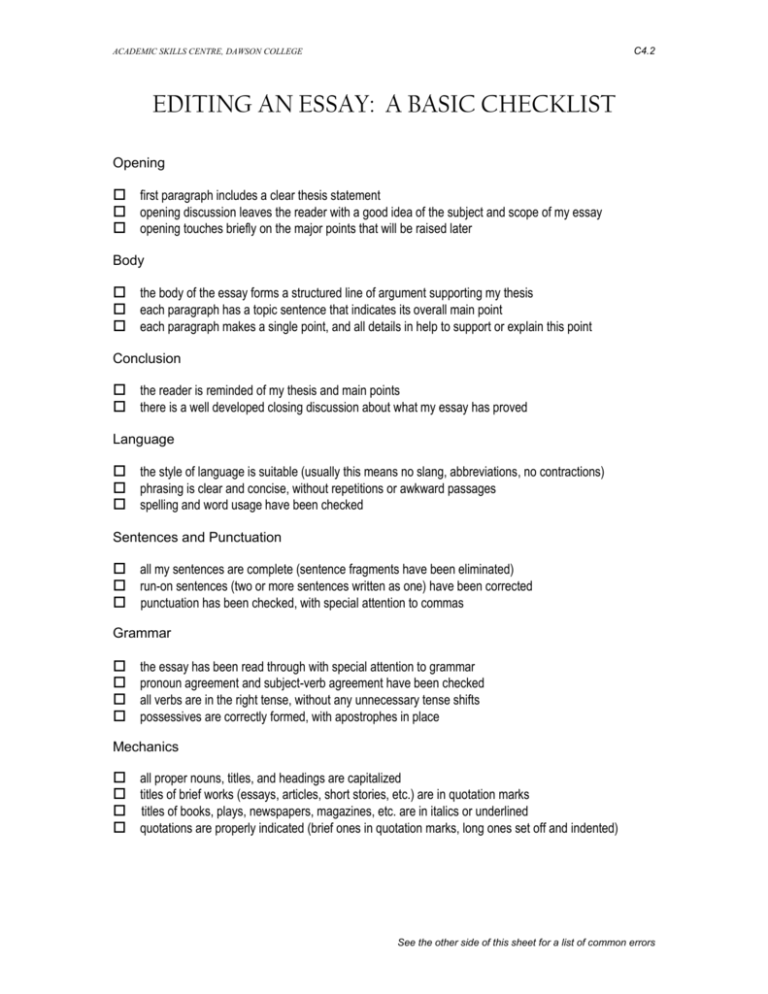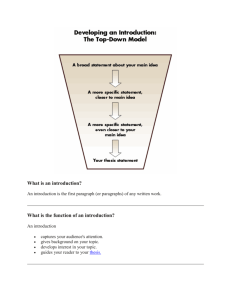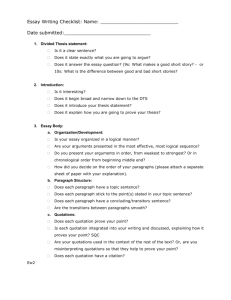EDITING AN ESSAY: A BRIEF CHECKLIST
advertisement

C4.2 ACADEMIC SKILLS CENTRE, DAWSON COLLEGE EDITING AN ESSAY: A BASIC CHECKLIST Opening first paragraph includes a clear thesis statement opening discussion leaves the reader with a good idea of the subject and scope of my essay opening touches briefly on the major points that will be raised later Body the body of the essay forms a structured line of argument supporting my thesis each paragraph has a topic sentence that indicates its overall main point each paragraph makes a single point, and all details in help to support or explain this point Conclusion the reader is reminded of my thesis and main points there is a well developed closing discussion about what my essay has proved Language the style of language is suitable (usually this means no slang, abbreviations, no contractions) phrasing is clear and concise, without repetitions or awkward passages spelling and word usage have been checked Sentences and Punctuation all my sentences are complete (sentence fragments have been eliminated) run-on sentences (two or more sentences written as one) have been corrected punctuation has been checked, with special attention to commas Grammar the essay has been read through with special attention to grammar pronoun agreement and subject-verb agreement have been checked all verbs are in the right tense, without any unnecessary tense shifts possessives are correctly formed, with apostrophes in place Mechanics all proper nouns, titles, and headings are capitalized titles of brief works (essays, articles, short stories, etc.) are in quotation marks titles of books, plays, newspapers, magazines, etc. are in italics or underlined quotations are properly indicated (brief ones in quotation marks, long ones set off and indented) See the other side of this sheet for a list of common errors COMMON FAULTS AFFECTING STUDENT ESSAYS Content Undeveloped opening paragraph: just a thesis without any discussion, without any overview of the essay’s main points Paragraphs that open with a detail instead of a comprehensive topic sentence Paragraphs that drift off the topic, or that include several main ideas Quotations that are simply ‘stuck in’—not smoothly integrated into the essay, and/or not properly discussed or explained Undeveloped conclusions: a sentence or two instead of an effective, interesting closing discussion Writing Style Awkward phrasing: cases in which there is a clearer, more straightforward way to make your point or a better way to organize a sentence. Wordiness (too many words where fewer would be more effective), unnecessary words and phrases that should have been edited out, repetition and redundancies. Two or more sentences written as one (run-on sentences or comma splices). In many cases, the problem is a comma placed where a period or semicolon is needed. Tense shifts: e.g. switching back and forth from present to past for no reason Careless errors in word usage (e.g. there in place of their, were for where, than for then). These can be missed due to reliance on spell-check systems as a substitute for proofreading. Apostrophe errors, usually in forming possessives (society’s problems; two students’ work) Faults in agreement involving pronouns (e.g. one student submitted their her paper early; someone lost their his wallet) Errors in subject-verb agreement (e.g. neither of them want wants to do it; many newspapers including The Gazette is are published daily) Faults in parallelism: every item in a list should be in the same form (e.g. She enjoys skating, skiing, and her snowboard snowboarding) Note: If you have difficulty understanding or recognizing any of these errors, visit the Academic Skills Centre for assistance. WM 2003








